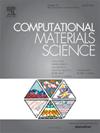The yield volume fraction approach to the description of the stress–strain curve of a nickel-base superalloy
IF 3.1
3区 材料科学
Q2 MATERIALS SCIENCE, MULTIDISCIPLINARY
引用次数: 0
Abstract
The stress–strain curves of most metallic alloys are often described using the relatively simple Ramberg-Osgood relationship. Whilst this description captures the overall stress–strain curve under monotonic tensile loading with reasonable overall accuracy, it often presents significant errors in the immediate post-yield region where the interplay between the elastic and plastic strains is particularly significant. This study proposes and develops a new approach to the description of the tensile stress–strain curve based on the Yield Volume Fraction (YVF) function. The YVF description provides an excellent match to experimental stress–strain curves based on a physically meaningful parameter that corresponds to the cumulative volume fraction of the polycrystal that undergoes yielding during monotonic deformation. The statistical nature of the polycrystal yield phenomenon is highlighted by the fact that the YVF model achieves good agreement with observations when the lognormal and extreme value distributions are employed to express the cumulative density function for the total yield volume fraction, and the probability density function for the incremental yield volume fraction, respectively. This proposed approach is compared with crystal plasticity finite element (CPFE) simulations and different constitutive equations, along with experimental observations. The results highlight the potential of more extensive use of statistical methods in the description of material deformation response for improved design.

求助全文
约1分钟内获得全文
求助全文
来源期刊

Computational Materials Science
工程技术-材料科学:综合
CiteScore
6.50
自引率
6.10%
发文量
665
审稿时长
26 days
期刊介绍:
The goal of Computational Materials Science is to report on results that provide new or unique insights into, or significantly expand our understanding of, the properties of materials or phenomena associated with their design, synthesis, processing, characterization, and utilization. To be relevant to the journal, the results should be applied or applicable to specific material systems that are discussed within the submission.
 求助内容:
求助内容: 应助结果提醒方式:
应助结果提醒方式:


